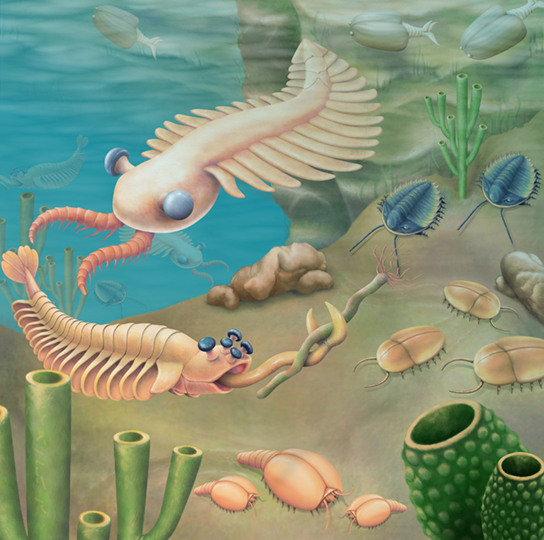Is Scientific Naturalism Dead?
Scientific naturalism or materialism is the worldview that the universe is the extent of all reality. Thus, all that occurs is the result of natural processes and laws.1 The prominent atheist philosopher Thomas Nagel affirms, “among the scientists and philosophers who do express views about the natural order as a whole, reductive materialism is widely assumed to be the only serious possibility.”2 But is the confidence often found in the academy for naturalism as a worldview justified? The emerging data and converging lines of reasoning show that confidence in naturalism is misplaced.
In my recent book, Jesus Is God and Savior, I explain and critique what naturalists affirm about important existential questions. In this post, I will briefly discuss six things naturalists affirm and show how the evidence and reasoning contradict these views.
Figure 1: Complex aquatic creatures of the Cambrian period appeared without signs of evolution from previous animals. Image credit: Wikimedia Commons
Naturalist Affirmation 1: God does not exist.
In Does God Exist? philosopher William Lane Craig presents several arguments for God’s existence.
Craig casts the teleological argument in terms of the fine-tuning that is observed in the universe. What is the source of the fine-tuning? Is it necessity, chance, or design? Craig concludes that the fine-tuning is not due to necessity since the physical constants of the universe could be other than they are.3 Astrophysicist Hugh Ross has shown that the probability that the constants of the universe could be set as they are on a random basis is virtually zero. Ross writes, “Unless the number of electrons is equivalent to the number of protons to an accuracy of one part in 1037 or better, electromagnetic forces in the universe would have overcome gravitational forces so that galaxies, stars, and planets would never have formed.”4 Yet the probability of finding a life-supporting planet in the entire universe is even more remote. Ross has compiled a list of 676 parameters that must be fine-tuned to permit life on a planet. He estimates that the probability of finding a life-permitting planet, apart from divine intervention, is one in 10556.5
Thus, necessity and chance are ruled out and design emerges as the only reasonable explanation for the fine-tuning of the universe. The Designer (God) must be immensely powerful and knowledgeable. If God exists, it cannot be the case that only the universe exists.
Naturalist Affirmation 2: Life arose by naturalistic means.
In a now-famous letter from February of 1871, Charles Darwin wrote to Thomas Hooker and suggested that the production of a living organism might have taken place “in some warm little pond with all sorts of ammonia & phosphoric salts,—light, heat, electricity” present.6 Darwin’s letter to Hooker fanned the flames of the chemical evolution movement, asserting that the origin of the first living cell was the result of random and chemical processes. Without the first living cell, evolution by natural selection (ENS) could not commence. But did the first living cell arise by chemical evolution? According to Nobel laureate Jack Szostak and Harvard-affiliated researcher Alonso Ricardo, “It is virtually impossible to imagine how a cell’s machines, which are mostly protein-based catalysts called enzymes, could have formed spontaneously as life first arose from nonliving matter around 3.7 billion years ago.”7
Stephen Meyer, philosopher of science and author of Signature in the Cell, estimates the probability of a minimally complex cell arising by random chance and chemical evolution is one in 1041,000.8 Thus, Meyer concludes, “The probability of producing the proteins necessary to build a minimally complex cell—or the genetic information necessary to produce those proteins—by chance is unimaginably small.”9
Naturalist Affirmation 3: The present diversity of life is the result of evolution by natural selection.
If the theory of evolution by natural selection is correct, the present observed diversity of life should be preceded by almost countless transitional forms as mutations gradually accumulated to form new species. Perhaps the most conspicuous failure of ENS is the rapid speciation during the Cambrian era recorded in the Burgess Shale in the Canadian Rockies. The Cambrian explosion of life began about 540 million years ago and, by one estimate, lasted only 410,000 years.10 During this period, most of the 30 animal phyla present today appeared in a period too short to allow for the gradual ENS envisioned by Darwin. Cambrian-era creatures contained trillions of cells. In contrast, Harvard paleontologist Stephen Jay Gould noted that the creatures of the Precambrian period found just below Cambrian shale layers were mere bacteria and blue-green algal cells devoid of nuclei and mitochondria.11 In recognition of the Cambrian fossil problem, evolutionary biologist Richard Dawkins opines, “the only alternative explanation of the sudden appearance of so many complex animal types in the Cambrian era is divine creation.”12 Dawkins rejects that alternative without providing rationale for his rejection.13
Naturalist Affirmation 4: The mind is a product of the brain which ceases to exist upon death.
Naturalists often argue that the mind is a product of the brain and the physiological processes in the central nervous system. Thus, they would affirm that when the body dies, the mind dies, and no afterlife is possible. However, evidential near-death experiences (NDEs) show that the mind continues to function even after clinical death (pulse and breathing have stopped) or brain death (flat-line EEG). In contrast to heavenly NDEs (in which the person claims they saw heaven), evidential NDEs take place on Earth, as those who are resuscitated from clinical and brain death provide verifiable and correct information regarding the events occurring during their incapacitated state.14 According to the radiation oncologist and recognized NDE researcher Jeffrey Long, “Near-death experiences (NDEs) are reported by about 17% of those who nearly die.”15
In their book, Beyond Death: Exploring the Evidence for Immortality, professors Gary Habermas and J. P. Moreland give numerous examples and reference large studies of corroborated evidential NDEs occurring in individuals who were comatose, clinically dead, or had flatline EEGs. Yet, upon resuscitation, these individuals are often able to provide details of their treatment, events in the hospital outside of the treatment setting, and sometimes events occurring in their homes or elsewhere. Evidential NDEs demonstrate that the mind can function apart from the body, showing that the mind is distinct from the body.16
Naturalist Affirmation 5: Humans are the ultimate source of morality.
Christian thinkers such as C. S. Lewis and William Lane Craig have defended the moral argument for the existence of God, stating that humans are imbued with a universal moral code or objective moral values that transcend time and location. Societies in recorded history have prohibited stealing, the murder of innocents, rape, bearing false witness, and other injustices. If God does not exist, there are no objective moral values. In the Darwinian framework, survival of the fittest is incompatible with the altruism and longing for justice found in all human beings. But in a theist framework, altruism and a desire for justice make perfect sense. If there are universal moral laws, there must be a universal moral Lawgiver (God) who is the source of morality. Some have argued that the universal moral code is a result of ENS. Yet, if that were the case, there would be morals, but not objective morals. That is to say, under different evolutionary pressures, a culture might have evolved where the murder of innocents, rape, and injustice were viewed positively, which is hard to conceive.17
Naturalist Affirmation 6: Jesus was a mere mortal.
Finally, contrary to naturalists’ skepticism, the best explanation for the historical events which occurred in the first century is that Jesus rose from the dead. Resurrection scholars Gary Habermas and Michael Licona defend the resurrection on the basis of four minimal facts. Their argument does not presume the truth of the Bible since it only uses facts accepted by virtually all New Testament scholars—conservative, liberal, skeptical, and agnostic. The facts are as follows:
- Jesus died by crucifixion.
- Jesus’s disciples believed he rose from the dead and appeared to them.
- The church persecutor Paul was suddenly converted.
- The skeptic James, the brother of Jesus, was suddenly converted.
A fifth fact would be affirmed by about 75% of the same group of scholars: The tomb of Jesus was empty on Sunday morning.18 In The Case for the Resurrection of Jesus, Habermas and Licona consider all naturalistic explanations for the minimal facts and they show, one by one, why they all fail. Thus, they conclude that the best explanation for the minimal facts is that Jesus rose from the dead. Since a dead man could not raise himself, the minimal facts point to a transcendent God who controls natural processes and Jesus as his divine agent who entered space-time.
Naturalism Is a Failed Worldview
This brief presentation of evidence and reasoning contradicts six naturalists’ affirmations while affirming the Christian theist worldview. How many strikes must naturalism be afforded before it is ruled out as a viable worldview? Insight into the lengths that atheists and naturalists will go to preserve the possibility of a purely material world is found in Thomas Nagel’s candid revelation.
I want atheism to be true and am made uneasy by the fact that some of the most intelligent and well-informed people I know are religious believers. It isn’t just that I don’t believe in God and, naturally, hope that I’m right in my belief. It’s that I hope there is no God! I don’t want there to be a God; I don’t want the universe to be like that.19
The retreat from the Christian theist worldview has been hasty and ill-founded in light of the evidence. As Paul writes in Romans 1:18, men suppress the truth in unrighteousness. One day, all the unrighteousness and desires of humans will be swept aside as Jesus, the King of kings and Lord of lords (Revelation 19:11–16), returns on the clouds of heaven with power and great glory (Matthew 24:29–31). Thus, the urgency to the share the gospel of Jesus Christ has never been greater.
Endnotes
- Steven Schafersman, “Naturalism is Today an Essential Part of Science,” Conference on Naturalism, Theism and the Scientific Enterprise, accessed August 14, 2022, https://holtz.org/Library/Philosophy/Metaphysics/Naturalism%20by%20Schafersman%201997.html.
- Thomas Nagel, Mind & Cosmos: Why the Materialist Neo-Darwinian Conception of Nature Is Almost Certainly False (Oxford: Oxford University Press, 2012), 4.
- William Lane Craig, Does God Exist? (Pine Mountain, GA: Impact 360, 2014), 496-704, Kindle.
- Hugh Ross, The Creator and the Cosmos (Covina, CA: RTB Press, 2018), 170.
- Ross, The Creator and the Cosmos, 216–218.
- Darwin Correspondence Project, “Letter no. 7471,” accessed March 4, 2023, https://www.darwinproject.ac.uk/letter/?docId=letters/DCP-LETT-7471.xml.
- A. Ricardo and J. W. Szostak, “Origin of Life on Earth,” Scientific American, September 1, 2009, https://doi.org/10.1038/scientificamerican0909-54.
- Stephen C. Meyer, Signature in the Cell: DNA and the Evidence for Intelligent Design (New York: Harper One, 2009), 213.
- Meyer, Signature in the Cell, 213.
- Ulf Linnemann et al., “New High-Resolution Age Data from the Ediacaran-Cambrian Boundary Indicate Rapid, Ecologically Driven Onset of the Cambrian Explosion,” Terra Nova 31, no. 1 (February 2019): 49–58, doi:10.1111/ter.12368.
- Stephen Jay Gould, The Panda’s Thumb (New York: Norton, 1980), 139.
- Richard Dawkins, The Blind Watchmaker (New York: Norton, 1996), 230.
- Dawkins, The Blind Watchmaker, 230.
- Daniel Cote, Jesus Is God and Savior: How Prophecy, Science, and History Affirm the Truth of Christianity (Watertown, CT: Multimedia Apologetics, 2022), 193.
- Jeffrey Long, “Near-death Experience. Evidence for Their Reality,” Missouri Medicine 111, no. 5 (September–October 2014): 372–380, doi:.
- Gary R. Habermas and J. P. Moreland, Beyond Death (Eugene, OR: Wipf & Stock, 1998), 155–172; Cote, Jesus Is God and Savior, 193–200.
- Cote, Jesus Is God and Savior, 31–34.
- Gary R. Habermas and Michael R. Licona, The Case for the Resurrection of Jesus (Grand Rapids, MI: Kregel, 2004), 48–76.
- Thomas Nagel, The Last Word (Oxford: Oxford University Press, 1997), 130.






